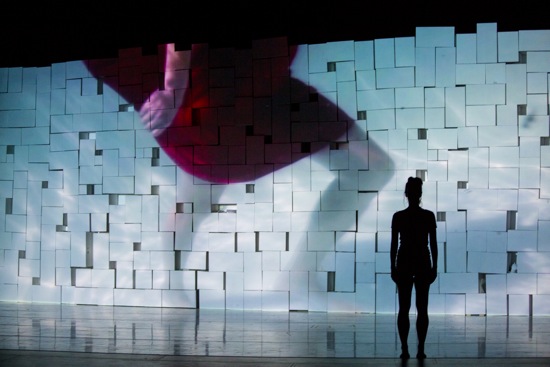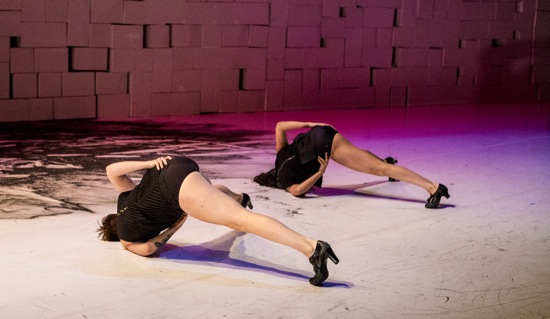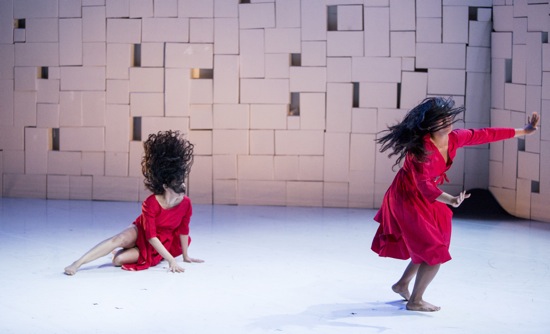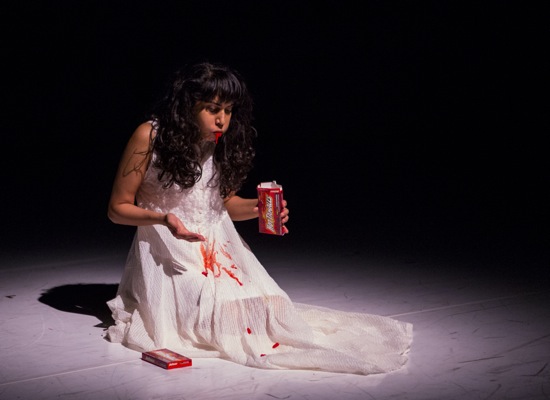Two choreographers, Pat Graney and Colleen Thomas, tackle issues, such as gender roles, in very different ways.
The 1960s weren’t all about Beatles, sit-ins, marches, pot, and communes. For many women, the post-war 1940s and the 1950s lingered on in spirit. Some of these women may have worn go-go boots and very short dresses, but they belonged to the unspoken club of wives who greeted their hard-working husbands at the door with a martini in hand and perfume on their ear lobes. Occasionally husbands boasted about their cooking prowess (i.e. throw a steak on the barbecue); some could change diapers. These too are cultural stereotypes, ready to be dissected.
Girl Gods is the second piece in a projected triptych created by the Seattle choreographer Pat Graney. Montclair University’s Peak Performances series did us a favor by bringing us its East coast premiere. Graney’s subject is women of a generation or two ago—women who were advised to bottle up their rage, to defer to their husbands, and to be capable and attractive on the home front at all times. Girl Gods is dedicated to Graney’s mother, who was diagnosed with Alzheimer’s, and I believe it is her recorded voice that we hear in snatches, recalling her married life and sometimes marveling at her own passivity.
The piece’s opening image is alarming. A woman in a short black dress and matching high heels attempts to carry a presumably full teacup across the stage. She (Sara Jinks) walks slowly and unsteadily, focusing on her task with the nervous tension of someone carrying an explosive that mustn’t be jostled. The audience in the Kasser Theater can hear the cup quake in its saucer.
With her free hand, Jinks helps herself along by touching the “wall” that stretches along the back of the stage. Amiya Brown’s lighting makes her blurry shadow grow and distort against it. Will this woman make it to her destination no matter how debilitating her condition?
The wall, designed by Holly Batt, is a marvelous thing, and John DeShazo’s engineering enables surprising effects. The nearly ceiling-high set is constructed of boxy white shapes—square or rectangular, vertical and horizontal. But the five women in Girl Gods are familiar with this wall; it’s their kitchen. One box opens like an oven; another holds trash. Jenny Peterson surreptitiously leaves a tea party, at which the hostess doles out tiny portions of a very small cake, and pulls out a whole section of the wall, as if it were an enormous drawer. Then she clambers up the stairway that results, retrieves a big, gooey-looking dessert from a high cupboard, and devours it.
Graney’s choreography takes several basic forms. At times, the women move through seductive poses and gestures, wooing us with “cute” and “sexy.” When their anger erupts, it either does so in tantrums or in controlled physical ordeals in a surreal gym. Our hearts sink when a very small girl appears and copies Cheryl Delostrino’s gestures—half aggression, half seduction, and, sure enough, Delostrino, Peterson, Jinks, Jody Kuehner, and Sruti Desai later appear in outrageous, fluffy, little-girl party dresses with bows in their hair. Thus accoutered, they smile and mince about like the “ladies” they’re being groomed to be.
Desai and Delostrino appear at one point in red dresses (costumes by Frances Kenny), with their copious black hair unbound; they hurl themselves around—thrashing, spinning, falling, rolling—for a punishingly long time. Their misshapen shadows echo them on the wall. Once Desai screams in rage. However, Graney’s social and political insights are most vivid in the vignettes she devises. The aproned Jinks takes a raw chicken out of a “refrigerator,” sets it on a table and proceeds to stuff it viciously with far more than it can hold. In another illustration of repressed rage, Desai, wearing a white dress sits on the floor and starts pushing Hot Tamales into her mouth. She chews and chews these cinnamon candies that she probes out of a small box, but doesn’t swallow them; her pretty face distorts; her cheeks distend; red syrup starts to pour from her mouth. It’s a horrifying sight. She’s about to start on a second box when the lights, mercifully, go out.
Much of the women’s buttoned-up anger focuses on the images inflicted on them, or ones in which they’ve been trained. And on the cruelty that some of them accept as part of their lives. Once, a song emerges in Amy Denio’s sensitive, responsive sound score; the words accompany a side-by-side, aggressively cute number performed by Delostrinos and Kuehner: “He hit me, and it felt like a kiss.”
Tall Kuehner patiently dresses herself in clothes sized for a ten-year-old, with results both hilarious and extremely sad. Peterson lays a small pad on the floor beside the wall and stands on her head; maintaining that uncomfortable position, she undresses herself down to her underwear. Make of it what you will (self-punishment, self-mastery, kinky sex ahead?); it too is as disturbing as it is laugh-producing. It’s also disturbing to watch Jinks and Delostrinos get hold of a doll that the little girl has dressed and make it walk toward the front of the stage. The doll becomes increasingly violent—small arms waving, feet kicking out. The two women get her where they want her, and she stands alone for the rest of Girl Gods, staring out at us; in the end, she’s in her own spotlight.
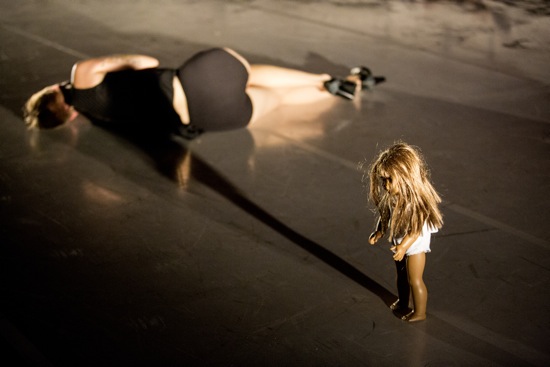
Little dolls and the big girls they grow into. Jody Kuehner and role model. Photo: Marina Levitskaya
Watching Graney’s piece and processing the often visceral sensations it awakened, I became surprised that, until the end, the five vibrant performers rarely acknowledged, never helped one another. Is it Graney’s point that they concealed their rage even from one another? Finally, however, when Peterson doesn’t recover from an exhausting fit of writhing and screaming, the others rise and lay her out. They undress her, and, two of them dip pieces of paper in a basin of water, and place them over her. Their gentleness and deliberateness give the scene the air of a ritual bath. Yet when they finish and set Peterson on her feet, we can see that her naked body is covered with writing. Maybe she is clothed in all the strictures her mother and her grandmothers passed down to her. They look like bruises. She lies down again, and the women circle her, making rings of dirt and dropping flowers into it as they walk around and around and around. A memorial for sure, but also, perhaps, a new beginning.
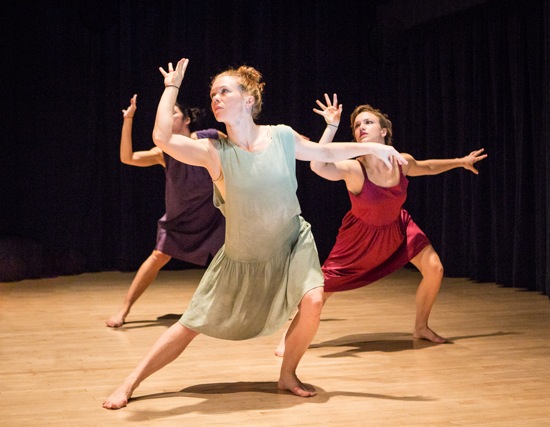
Colleen Thomas’s Her(e) Repetitive Blueprint. (L to R): Thomas (hidden), Jenna Riegel, and Jessica Stroh. Photo: Yi-Chun Wu
A day later, I’m in Buttenweiser Hall where the 92nd Street Y Harkness Dance Center’s Dig Dance! Series is happening. I haven’t looked closely at the program for Colleen Thomas’s new Her(e) Repetitive Blueprint. As the work begins, and on the basis of its startling first moments, I assume it’s a dance for women. The only man in sight is the composer-musician John McGrew. He’s singing softly and holding slightly open a curtain that conceals a window; he looks out. Thomas herself is dancing, sometimes gazing upward toward a corner of the space. A side door opens, releasing a beam of light, and she reaches into the room beyond and pulls out another woman (Samantha Allen). Allen, thrashing as if loath to leave her lair, breaks loose. As she travels on her own wild path, two other women (Jenna Riegel and Jessica Stroh) emerge one at a time from that same room and stand behind Thomas. They’re wearing loosely cut dresses in different colors (costumes by Rachel Jones Bellas). Side by side, the three fall to the floor face down, squirming a little, shaking their heads. There’s a sound of rattling, of thunder; an echoing female voice sings.
Tricia Toliver’s lighting is both imaginative and, I suspect, partly make-do. Sometimes the fine old room’s several chandeliers provide the light, but when the four women line up, the smartly dressed Tamara Joy Clark, who acts as a hostess-helper-performer, switches on a lamp for each dancer (these lights sit right at the feet of front-row spectators). In that illumination, the women, rubbing their bellies vigorously—perhaps trying to cleanse themselves of something—look almost spectral.
They may use those light paths, moving along them, say, or, their backs to us, jumping many times in their own bright areas. Their movements have a certain looseness; they fling their arms and legs as they leap; they swing their bodies. They divide into two-part counterpoint. Falling is a major ingredient of the choreography. And those risen keep helping others up, only to fall themselves. Sometimes McGrew’s music stops; at other times it’s strong, almost abrasively loud and/or insistently rhythmic, but it’s always geared to what the dancers do.
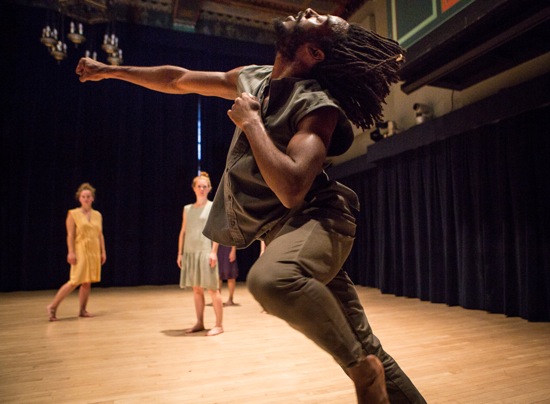
Orlando Hunter in Colleen Thomas’s Her(e) Repetitive Blueprint. Watching (L to R): Samantha Allen and Jenna Riegel. Photo: Yi-Chun Wu
Just as I’m beginning to wonder how Thomas is going to draw this activity out into a full-evening piece, the lights go out. When they come on again, a shock! At least to me. Four men have materialized: Ehizole Azeke, Orlando Hunter, Marc Mann, and Nathan Trice. All are black, just as the women are all white. Thomas, I think, wants us to notice that fact and to consider gender and racial differences not as political or social issues, but in terms of human beings fulfilling together the dance she has created. In the somewhat oblique program note I later read in the subway, she mentions how the clarity of our perception may be compromised if “we are beholden to the stories we keep telling ourselves.” And while there is “no clean slate,” she warns that we must try to cut away some of the narratives that inevitably cling to what we see here and now.
The men execute some of the same maneuvers that the women have done, and the women periodically repeat their steps. The men too tread the light paths. But they also have new images to communicate. Hunter stalks along, bent over, and rippling his uncannily sinuous torso; he circles the activities with an almost frantic energy and big flung out, staggering steps. A runway walk by some of the men crops up a few times, further summoning up the porousness of gender.
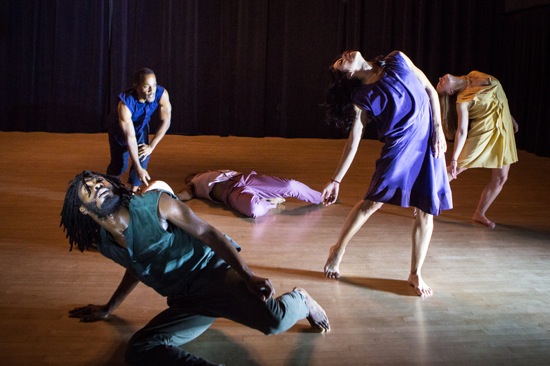
Colleen Thomas’s Her(e) Repetitive Blueprint. (L to R): Orlando Hunter, Nathan Trice, Marc Mann, Colleen Thomas, and Samantha Allen. Photo: Yi-Chun Wu
What happens after a while starts messing with my head, and the title Her(e) Repetitive Blueprint acquires more resonance. At times, it’s as if the pattern that contains the men has been laid over the women’s pattern. Dancers in the two units pass between and around one another without showing any recognition of the fact that they are sharing the space. Amazing. Fascinating. It’s a shock when Allen falls on top of Azeke and lies there for a time. Various of the men and the women do eventually perform the same steps at the same time; Trice and Allen, as I recall, swing their bodies in unison, fall and pull each other up. But physical contact between members of the two segregated groups is rare.
Images reappear in new contexts—the door opening, the beam of light, Thomas yanking Allen in, the gazes to a high corner. The scene at the window recurs in altered form too, just at the end of the piece. McGrew leaves the piano and his electronic equipment and pulls the curtain aside again, and Clarke reaches out to hold it, while the others dance swiftly, each different from everyone else. Mann takes a turn holding the curtain so that the two musicians can face us and sing quietly and sweetly. There are words I can’t quite make out. I thought I heard this: “I shall find a way to tell you everything by saying nothing.”

